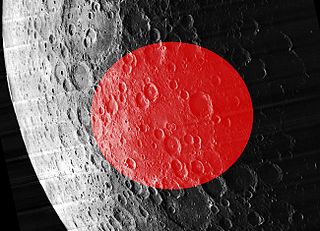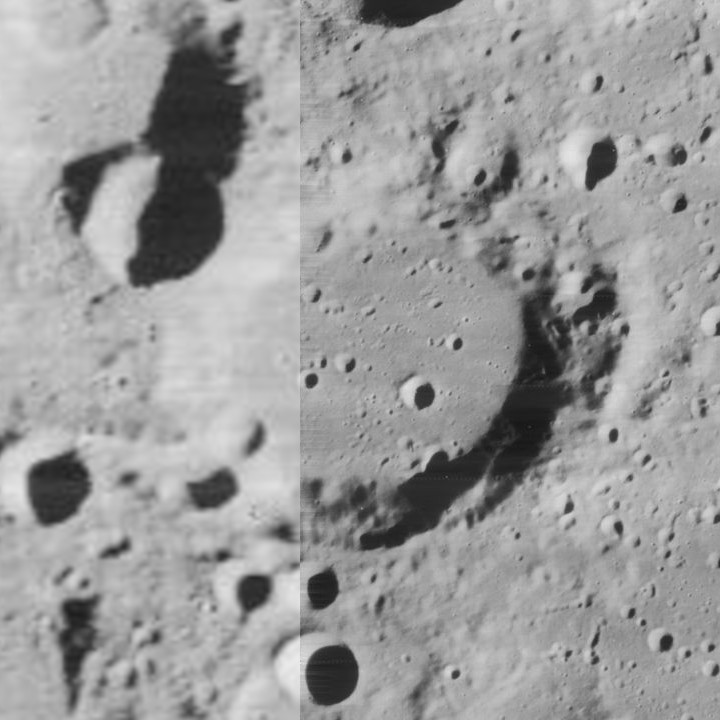 Landau from orbit. | |
| Coordinates | 41°36′N118°06′W / 41.6°N 118.1°W Coordinates: 41°36′N118°06′W / 41.6°N 118.1°W |
|---|---|
| Diameter | 214 km |
| Depth | Unknown |
| Colongitude | 121° at sunrise |
| Eponym | Lev D. Landau |


Landau is a large lunar impact crater that is located in the northern hemisphere on the far side of the Moon. It was named after physicist Lev Landau. The crater Wegener is attached to the northeastern rim. Attached to the southeastern rim is Frost.

Lunar craters are impact craters on Earth's Moon. The Moon's surface has many craters, almost all of which were formed by impacts.

An impact crater is an approximately circular depression in the surface of a planet, moon, or other solid body in the Solar System or elsewhere, formed by the hypervelocity impact of a smaller body. In contrast to volcanic craters, which result from explosion or internal collapse, impact craters typically have raised rims and floors that are lower in elevation than the surrounding terrain. Impact craters range from small, simple, bowl-shaped depressions to large, complex, multi-ringed impact basins. Meteor Crater is a well-known example of a small impact crater on Earth.

Earth's Moon is an astronomical body that orbits the planet and acts as its only permanent natural satellite. It is the fifth-largest satellite in the Solar System, and the largest among planetary satellites relative to the size of the planet that it orbits. The Moon is, after Jupiter's satellite Io, the second-densest satellite in the Solar System among those whose densities are known.
The outer rim of Landau is heavily eroded and modified by subsequent impacts. The most notable of these is Wood, which overlays the northwest rim. Much of the floor is hilly and irregular, with only the northeast quadrant being somewhat level. There are multiple small craters and craterlets in the floor. The most intact section of the rim is in the southwest, although this is now little more than a low ridge line.

Wood is a lunar impact crater that lies entirely within the interior of the much larger walled plain Landau, on the far side of Moon. Wood is situated along the northwestern part of the floor of Landau, and shares a common northwestern rim with the larger impact. The inner wall of the northwest rim extends inward about halfway toward the crater midpoint, where there is a central peak. The rim of Wood is somewhat worn and uneven, with a small crater laid across the southwest section. The surviving interior floor is nearly level and is marked only by a few tiny craterlets.
Landau lies at the approximate margin of the Coulomb-Sarton Basin, a 530 km wide impact crater of Pre-Nectarian age.

The Coulomb-Sarton Basin is a Pre-Nectarian impact basin on the far side of the moon. It is named after the crater Coulomb northeast of the center of the basin and the smaller crater Sarton just south of the center. The basin is not obvious on the lunar surface. There are only small fragments of inner rings and a rim, and the most indicative topographic feature is a smooth, low plain at the center.
The pre-Nectarian period of the lunar geologic timescale runs from 4.533 billion years ago to 3.920 billion years ago, when the Nectaris Basin was formed by a large impact. It is followed by the Nectarian period.






















